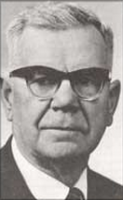










Alfred Hermann Traeger (1895-1980), engineer, was born on 2 August 1895 at Glenlee, Dimboola, Victoria, eldest son of Johann Hermann Traeger, farmer, and his wife Louisa, née Zerna, both South Australian born. His German grandparents had migrated to South Australia in 1848 and his father returned there with his family in 1902. A curious, patient, precise child, at 12 Alfred made a telephone receiver and transmitted between the toolshed and his house. He attended Balaklava Public School and the Martin Luther School before spending two years at technical high school. From 1912 he studied mechanical and electrical engineering at the South Australian School of Mines and Industries (associate diploma, 1915). He worked for the Metropolitan Tramways Trust and the Postmaster-General's Department. In World War I he was angered that his application to join the Australian Flying Corps was refused, even though his grandparents had been naturalized. About 1923 Traeger joined Hannan Bros Ltd in Adelaide, handling their car generator and electrical repairs. Intrigued by radio, he obtained an amateur operator's licence and built his first pedal transmitter-receiver, later forming Traeger Transceivers Pty Ltd.
John Flynn was planning his Australian Inland Mission Aerial Medical Service for remote communities and from 1926 Traeger worked for him, at £500 a year, on Northern Territory radio experiments. After an outback tour of duty, Traeger began work in Adelaide on a transceiver for the flying doctor network. The sets had to be cheap, durable, small and easy to operate. Using bicycle pedals to drive the generator, he found that a person could comfortably achieve 20 watts at a pressure of about 300 volts. He enclosed the generator's fly-wheel and gears in cylindrical metal housing, with pedals outside and a cast base to be screwed on to the floor beneath a table. Traeger built the transceiver into a box, employing a master switch to separate the crystal controller transmitter from the receiver. His famous pedal wireless was actually a pedal-operated generator which provided power for a transceiver. Traeger's time was divided between his workshop and the field where he taught radio operating and Morse code; despite the heat, he wore a dark suit and braces.
Once the first pedal sets had been introduced in Queensland in 1929, the invention created a communications revolution by diminishing the loneliness of the inland world. In 1933 Alf invented a typewriter Morse keyboard, an accessory to the pedal sets which was widely used until the advent of radio telephony. In 1939 Traeger's set dispensed with pedals and adopted a vibrator unit. Emergency call systems linked inlanders with hospitals, and sets were used by the School of the Air, doctors, ambulances, councils, taxis, airways and ships.
In 1944 Traeger was appointed O.B.E. A stocky, dark-haired man, with spectacles and a scar on his left cheek, he was friendly, but shunned publicity: his work was his life. He was a member of the Institution of Radio Engineers, Australia. He had married Olga Emilie Schodde (d.1948) in Adelaide on 11 November 1937. On 2 August 1956 he married a 29-year-old widow, Joyce Edna Mibus, née Traeger.
In 1962 pedal sets were sold to Nigeria; in 1970 Traeger's firm provided an educational radio network for Canada. Traeger continued inventing: he designed a turbine-driven car and used solar power to convert salt water to fresh water. Survived by his wife, their son and two daughters, and by two daughters of his first marriage, he died on 31 July 1980 at Rosslyn Park, Adelaide, and was buried in Centennial Park cemetery. At Alice Springs a sports field, a plaque and the Royal Flying Doctor Service aeroplane commemorate him.